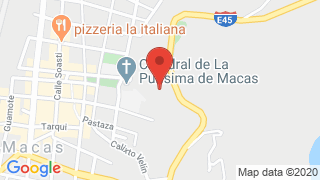Province Morona Santiago





Morona Santiago
The Temple of the Ecuadorian Amazon
The province of Morona Santiago is located in the southern center of the country, in the outer sides of the western mountain range to the west and the vast plain Amazon to the east.
The main economic activities are tourism, agriculture and commerce. It stands out for being a tourist area with peculiar attractions, like the Cave of the Tayos, the valleys of Upano, the Binational Condor Park that houses some native nationalities.
Climate of Morona Santiago
- The plateaus and valleys of rich vegetation define different floors climates with temperatures between 18 ° C and 23 ° C, the climates tropical and subtropical.
Morona Santiago ethnic groups
- The jungles of the province house three indigenous nationalities such as Achuar, Shiwiar and Shuar.
Agricultural products of Morona Santiago
- Morona Santiago is a prosperous province and its commercial products are sugar cane, naranjilla, tea, coffee and Yucca.
Morona Santiago Tourism
Tourist Attractions of Morona Santiago
- Kutuku Protected Forest: is subject to a study and management plan to be part of SNAP.
- Sardinayacu lagoons: 5 lagoons system, formed by the melting of the Sangay volcano and other currents that will form the Volcano river.
- Panía hot springs: Panía hot springs are located in natural pools 6 meters wide by 2 meters wide and 40 cm deep
- Waterfalls Arapicos: High waterfalls are Arapicos in the north at the corner of Morona in the upper area of Arapicos.
- The cathedral of Purísima de Macas: the first sanctuary was not a grand church, it was a cave that ran on a mountain in 1591.
- Shuar Community: this foundation consists of several Shuar original cabins built by the Bosco family that belong this ethnic group.
Typical food of Morona Santiago
- Among the most typical dishes is ayampaco, prepared with fish or chicken, palm and spices, wrapped in bijao leaves and baked.
- Other representative foods are roast, maneuver and tamale palm, fritters, cassava tortilla, sweat meat.
- There are others that are now more particular, such as bridal broth, beet, mashed with pelma, rumbuela, others.
- Among the most representative drinks are guayusa, cane chicha, chicha de chonta, chicha de yuca, drinks shared with the Shuar ethnic group.
Customs of Morona Santiago
Their traditions are influenced by ancestral cultural events.
- Chonta Festival: it is one of the most important events in the Shuar culture and represents the complete biological cycle of the plant (chonta) This is done in May when the fruit is harvested. Between the communities participating in this ceremony are San Luis de Iñimkis, Angel Ruby, among other Shuar communities.
- "El Randimpa": custom for Macas, It was in a community and solidarity work where the owner of a farm (orchard) called all his neighbors and friends to do a job, the same way he came back when he demanded it. Today, randimpa takes place when the holiday approaches and takes place to clean the entire city, they get involved, institutions, schools and the general public.
- Crafts: The indigenous population has developed a folk-type craft that contains cultural elements and reveals the enormous originality of its inhabitants
History of Morona Santiago
The jungles are the cradle of the three native nationalities of the Amazon of the Equatorial Region: Achuar, Shiwiar and Shuar. He had different migratory periods from the upanos.
The Spanish colonization occurred in 1549 when Hernando de Benavente was allowed to explore the "lands of Macas" and 150 men they left Cuenca and faced resistance from the Shuar. The precursor of the province was the government of Macas. After the war of independence and the annexation of Ecuador to Colombia, the provinces of Chimborazo and Azuay were created on June 25, 1824, in which the current territory of Morón was within its limits. On November 10th 1953, the 16th province of the country, Morona Santiago, was dismantled from the province of Santiago Zamora.
Villanueva Maldonado, founded Sevilla de Oro in 1575.5 Subsequently, these lands were incorporated to the Governor of Quijos. The city was in the left bank of the Upano River, just south of the current Seville parish of Don Bosco, considered a residential and important city
until it was completely destroyed by the Shuar in 1599, who were overthrown for mistreating a part of the Spaniards. Few survivors of the massacre crossed the Upano River in the lands of Macadas, leaving the place where the current city of Macas is located.

Publicado en:
Publicado por:



